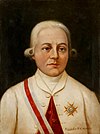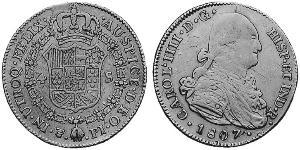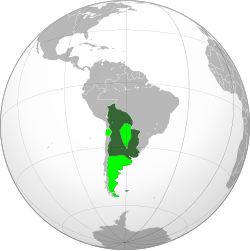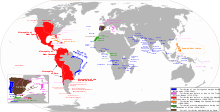| preceded by | ||||
|
||||
|
|||||||
|
|
|||||||
| Viceroyalty of the Río de la Plata (1776 - 1814)from the Wikipedia | Read original article |
| This article needs additional citations for verification. (January 2008) |
| Viceroyalty of the Río de la Plata | |||||
| Virreinato del Río de la Plata | |||||
| Viceroyalty of the Spanish Empire | |||||
|
|||||
|
|
|||||
| Motto Plus Ultra "Further Beyond" |
|||||
| Anthem Marcha Real "Royal March" |
|||||
|
Viceroyalty of the Río de la Plata and disputed
de jure extension (light green)
|
|||||
| Capital | Buenos Aires (1776-1810) Montevideo (1811-1814) |
||||
| Languages | Spanish | ||||
| Religion | Roman Catholicism | ||||
| Government | Monarchy | ||||
| King | Kings of Spain | ||||
| Viceroyalty | List of Viceroys | ||||
| List of Governors List of Intendentes |
|||||
| History | |||||
| - | Established | 1 August 1776 | |||
| - | British invasions of the Río de la Plata |
1st – 2 January 1806 2nd – 3 February 1807 |
|||
| - | May Revolution | 25 May 1810 | |||
| - | Independence of Paraguay | 14 May 1811 | |||
| - | Fall of Montevideo | 20 June 1814 | |||
| Currency | Spanish colonial real | ||||
The Viceroyalty of the Río de la Plata (Spanish: Virreinato del Río de la Plata) was the last and most short-lived Viceroyalty of the Spanish Empire in the Americas.
The Viceroyalty was established in 1776 out of several former Viceroyalty of Perú dependencies that mainly extended over the Río de la Plata Basin, roughly the present day territories of Argentina, Bolivia, Paraguay and Uruguay.[1] Buenos Aires, located on the western shore of the Río de la Plata estuary, opposite the Portuguese outpost of Colonia del Sacramento, was chosen as the capital. Usually considered one of the late Bourbon Reforms, its creation was both motivated on commercial grounds (Buenos Aires was by then a major spot for illegal trade), as well as on security concerns brought about by the growing interest some foreign powers had over the area, namely Great Britain and the Kingdom of Portugal.
However, the Enlightening reforms proved counterproductive, or perhaps too late to quell the colonies' demands. In fact, the entire existence of the Viceroyalty was characterized by growing unrest and instability. Between 1780 and 1782, the Rebellion of Túpac Amaru II inspired a violent Aymara-led revolt across the Upper Peru highlands, evidencing the huge resentment towards colonial authorities from both mestizos and indigenous populations. Twenty-five years later, two successive British attempts at conquering Buenos Aires and Montevideo were successfully repelled by Criollo-led defenses, enhancing their perceived autonomous capabilities as the Spanish troops were unable to help.
In 1809, the criollo elite revolted against colonial authorities at La Paz and Chuquisaca, establishing revolutionary Juntas. Albeit short-lived themselves, they provided some strong theoretical basis for the legitimacy of the locally-based governing juntas that proved decisive at the 1810 May Revolution events that deposed Viceroy Cisneros at Buenos Aires.
The revolution spread all over the Viceroyalty, except for Paraguay (which declared itself an independent nation in 1811) and the Upper Peru (which remained controlled by royalist troops from Lima, and was eventually re-incorporated into the Viceroyalty of Peru). Meanwhile, the Governor of Montevideo Francisco Javier de Elío, appointed as a new Viceroy by the Cortes of Cádiz in 1811, declared the Buenos Aires Junta seditious. However, after being defeated at Las Piedras he was only left in control of Colonia del Sacramento and Montevideo, so he returned to Spain on 18 November and resigned as Viceroy on January 1812. By 1814, as the patriots entered Montevideo, following a years-long siege, the Viceroyalty effectively ceased to exist.
Contents
History[edit]
Origin and creation[edit]
In 1680, Portuguese governor of Rio de Janeiro Manuel Lobo created the Department of Colonia and founded Colónia do Sacramento, a fort located in present Uruguay's coast and the department's capital. The main objective was to secure the Portuguese expansion of Brazil beyond the Treaty of Tordesillas that was rendered meaningless between 1580 and 1640 while Spain controlled Portugal. José de Garro quickly attacked and seized the fort for Spain, but on 7 May 1681 it was handed back to Portugal due to the Provisional Treaty of Lisbon.
On the other hand, the Viceroyalty of Peru required all commerce to be performed through Lima's port, which restrained the Buenos Aires natural port potential economy, a problem that also caused large contraband activities in the region, especially in Asunción, Buenos Aires and Montevideo.
Under these conditions, King Charles III of Spain issued a decree for the former Governor of the Río de la Plata Pedro Antonio de Cevallos creating the new viceroyalty, in August 1776. The ruling found resistance in Lima, but was enforced anyway. The Cabildo of the Captaincy General of Chile requested the King not to be included into the new viceroyalty, which was accepted.[2] However the Cuyo region with its main city Mendoza was split from the Captaincy General of Chile, something resented in Santiago since that region had been originally settled from Chile.
The Portuguese prime minister Marquis of Pombal continued to encourage the occupation of territory which had already been awarded to the Spanish in the Treaty of Paris (1763). King Charles III quickly reacted to the advantageous conditions: France was bound to be an ally as a guarantor of the treaty, and England due to its own colony problems couldn't help being neutral.
Pedro de Cevallos would then conquer Colonia del Sacramento and the Santa Catarina islands after a siege of three days, which led to the First Treaty of San Ildefonso. With it, the Portuguese would retire from the Río de la Plata and leave the Banda Oriental for Spain, but in exchange Spain would leave for them the area of Rio Grande do Sul. Cevallos ends his military actions at this point and starts working with government, but was soon replaced by Juan José Vertiz y Salcedo. One of their first tasks was to promote local production of linen and hemp, to provide the Spanish cloth industries that the Bourbons sought to favor.[2]
The early viceroyalty[edit]
The conditions imposed by Spain to local commerce were high, but Charles III sought to reduce them a little. One such ruling allowed commerce as long as ships were Spanish and manned with Spanish naval officers. The ports of Buenos Aires and Montevideo were included in a list of Spanish ports allowed to commerce between themselves, certain Spanish American productions were free of taxes to enter Spain, and all the cities with ports would have Consulates or Tribunals of Commerce. This system wasn't a system of free trade yet, but it would be an antecedent of it.[3] In the 1778-1788 period the commerce between Spain and Spanish America grew nearly 700%.[3] Buenos Aires would get its own customs in 1778, and Montevideo in 1789. Spanish policy aimed to truncate Argentina commerce and the Empire banned export of silver from Buenos Aires and tried to get all shipments out of Potosí.
The system of corregimientos to mark the subdivisions of the territory was ended in 1782, and replaced with Intendencias by another ruling of Charles III. The new system was intended to re-enforce the royal authority and promote centralization. Buenos Aires had the main intendencia, and the other cities provincial ones. Cevallos reinstated in 1778 the Real Audiencia of Buenos Aires, but not moving back the one from Cochabamba but creating a new one. The Consulate of Commerce of Buenos Aires was ruled to be created the same year, but legal difficulties delayed its actual creation up to 1794.
In 1766, Spain acquired the French colony on the Falkland Islands, called Port St. Louis, and after assuming effective control in 1767, placed the islands under a governor subordinate to the Buenos Aires colonial administration. The expulsion of the British settlement brought the two countries to the brink of war in 1770, but a peace treaty allowed the British to return from 1771 until 1776 with neither side relinquishing sovereignty.[4]
Decline[edit]
By the nineteenth century Buenos Aires was becoming more self-sufficient, producing about 600,000 cattle a year (of which about one quarter was consumed locally), prompting the development of the area.[citation needed] But wars with Great Britain meant a great setback for the region's economy as maritime communications were practically paralyzed. The Alto Peru region started to show contempt as the expenses of administration and defense of the Río de la Plata estuary were mainly supported by the declining Potosí production. For instance, in the first years of the viceroyalty, around 75% of the expenses were covered with revenues that came from the north. The Alto Plata (mostly present Paraguay) also had problems with the Buenos Aires administration, particularly because of the monopoly of its port on embarkations.
The Napoleonic Wars preoccupied the Spanish government and, in time, resulted in Napoleon's placing his brother Joseph on the Spanish throne. By 1805, Spain had to help France because of their 1795 alliance, and had lost its navy in the Battle of Trafalgar, but the Spanish prime minister had warned the viceroyalty of the likelihood of a British invasion, and that in such an event the city of Buenos Aires would be on its own.
On 27 June 1806, a small British force of around 1,500 men under Col. William Carr Beresford successfully invaded Buenos Aires after a failed attempt to stop him from viceroy Rafael de Sobremonte, who fled to Córdoba. The British forces were thrown back by the criollos on December 1806, a militia force from Montevideo under the leadership of Santiago de Liniers. In February 1807, British reinforcements of about 8,000 men under Gen. Sir Samuel Auchmuty captured Montevideo after a fierce fight, and in May Lt. Gen. John Whitelock arrived to take overall command and attacked Buenos Aires on 5 July 1807. After losing more than half his force killed and captured, Whitelock signed a cease-fire and left for Great Britain.
Thus, lack of support from Spain and the confidence-boost by the fresh defeat of a world power prompted a movement towards independence at the expense of the viceroyalty. As of 1814, Argentina had been self-governed for about four years, and Paraguay had already declared its independence, and the viceroyalty was effectively dissolved when the rebel troops entered Montevideo after a years-long siege.
Government[edit]
The Viceroyalty of the Río de la Plata was a viceroyalty created in 1776 by the Spanish king Charles III of Spain. Although it functioned as a Spanish colony, Río de la Plata was technically a personal possession of the King of Spain. This allowed both European Spain and its overseas territories to have their own laws and regulations.
Dependencies[edit]
- Intendency¹ of Buenos Aires: cities of Buenos Aires, Corrientes, Santa Fe, Colonia and Carmen de Patagones.
- Government² of Montevideo: city of Montevideo.
- Government of Misiones: cities of San Ignacio, Yapeyú and Candelaria.
- Intendency of Paraguay: city of Asunción
- Intendency of Córdoba: cities of Rio Cuarto, Córdoba, La Rioja, San Juan, Mendoza and San Luis
- Intendency of Salta: cities of Catamarca, Santiago del Estero, Tucumán, Salta and Jujuy
- Government of Chiquitos
- Intendency of Potosí: cities of Potosí and Oruro.
- Intendency of La Paz: city of La Paz.
- Intendency of Cochabamba: cities of Cochabamba and Santa Cruz de la Sierra.
- Intendency of Charcas: city of Charcas (modern Sucre).
- Government of Moxos
- ¹ Intendencia in Spanish.
- ² Gobernación in Spanish.
List of viceroys[edit]
The King of Spain appointed viceroys to govern in his name. In the beginning their terms had no fixed duration and may last for life, but afterwards they were shortened to periods of 3 to 5 years.[5] Because of the distances between Spain and America, and the means of transport available in that age, there were long delays between the designation of a viceroy and the viceroy's effectively taking power.
| # | Picture | Name | Term | Designation | Notes |
|---|---|---|---|---|---|
| 1 |  |
Pedro Antonio de Cevallos |
|
|
Appointed by Charles III of Spain |
| 2 |  |
Juan José de Vértiz y Salcedo |
|
|
Appointed by Charles III of Spain; resigned |
| 3 |  |
Nicolás del Campo |
|
|
Appointed by Charles III of Spain |
| 4 | Nicolás Antonio de Arredondo |
|
|
Appointed by Charles IV of Spain, resigned | |
| 5 |  |
Pedro Melo de Portugal |
|
|
Appointed by Charles IV of Spain, died in office |
| - | Real Audiencia of Buenos Aires |
|
Interim government until the arrival of a new viceroy | ||
| 6 |  |
Antonio Olaguer Feliú |
|
During his mandate, he had to contend with the presence of British and Portuguese forces in the Río de la Plata region, as well as nascent revolutionary sentiment inspired by the recent French Revolution. He opened the port of Buenos Aires to foreign traffic in a bid to stimulate the commercial activities of the Viceroyalty. | |
| 7 |  |
Gabriel de Avilés, 2nd Marquis of Avilés |
|
|
|
| 8 |  |
Joaquín del Pino y Rozas |
|
|
Appointed by Charles IV of Spain, died in office |
| 9 |  |
Rafael de Sobremonte |
|
|
During the British invasions of the Río de la Plata Buenos Aires and Montevideo fell under British authority for brief periods of time. Sobremonte was forced on 14 August 1806 by an open cabildo to move to Montevideo, delegating in Santiago de Liniers the military authority and in the Audience the other areas of government. He was removed completely as viceroy by a martial court, with Liniers elected as interim viceroy.[6] |
| 10 |  |
Santiago de Liniers |
|
Interim viceroy, confirmed in office by Charles IV of Spain, replaced by the Junta of Seville. | |
| 11 |  |
Baltasar Hidalgo de Cisneros |
|
|
Appointed by the Junta of Seville, ousted from office by the May Revolution, replaced by the Primera Junta. |
| 12 |  |
Francisco Javier de Elío |
|
|
Self-proclaimed viceroy after the May Revolution, confirmed as such by the Junta of Cadiz, which also declared Montevideo the new capital and Buenos Aires a rebel city.[6] |
See also[edit]
- List of Governors in the Viceroyalty of the Río de la Plata
- Argentine War of Independence
- United Provinces of the Río de la Plata
- History of Argentina
- History of Bolivia
- History of Paraguay
- History of Uruguay
References[edit]
- ^ "Map of the Eastern Republic of Uruguay, 1893". World Digital Library. 1893. Retrieved 2013-10-24.
- ^ a b Abad de Santillán, p. 195.
- ^ a b Abad de Santillán, p. 197.
- ^ Lewis, Jason and Alison Inglis. "A Brief History of the Falkland Islands: Part 2—Fort St. Louis and Port Egmont." Falklands Islands Information. Accessed 2007-09-08.
- ^ El Virreinato del Río de la Plata
- ^ a b Virreyes del Río de la Plata (Spanish)
Bibliography[edit]
- Abad de Santillán, Diego. Historia Argentina (in Spanish). Buenos Aires: TEA (Tipográfica Editora Argentina).
- Lynch, John. Spanish Colonial Administration, 1782-1810: The Intendant System in the Viceroyalty of the Río de la Plata. London, University of London, Athlone Press, 1958.
External links[edit]
| Wikimedia Commons has media related to Viceroyalty of Río de la Plata (Virreinato del Río de la Plata). |
|
||||||||||||||||||||||||
|
||||||||||||||||||||||||||||||||
|
||||||||||||
|
||||||||||||||||||||||||||||||||||||||
- Former monarchies of South America
- Former countries in South America
- Former vassal states
- States and territories established in 1776
- States and territories disestablished in 1814
- Viceroyalty of the Río de la Plata
- Viceroyalties of the Spanish Empire
- Colonial Argentina
- History of Uruguay
- History of Bolivia
- Former colonies in South America
- Former Spanish colonies
- Spanish colonization of the Americas
- History of South America
- 18th century in South America
- 19th century in South America
- Titles of nobility in the Americas













